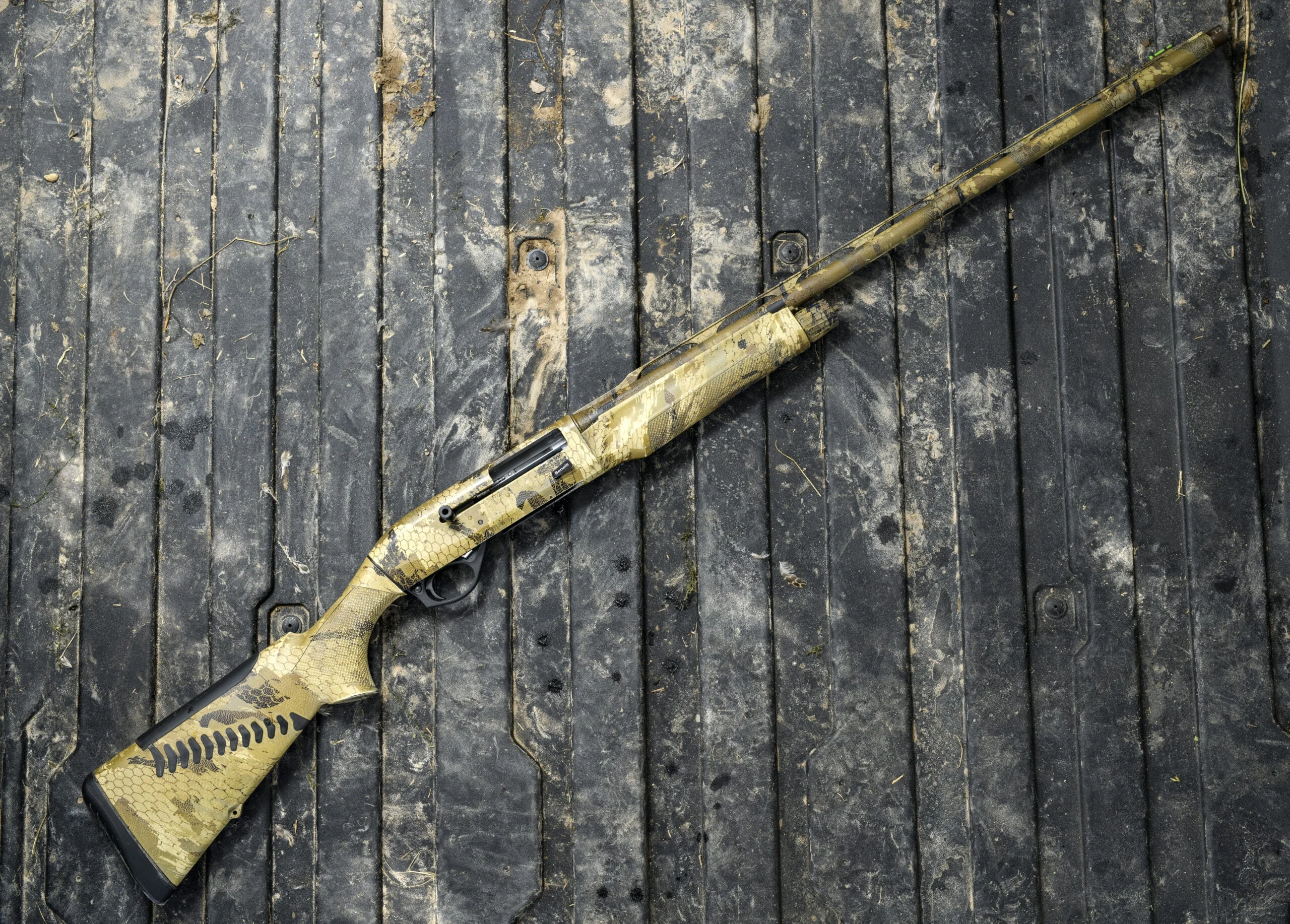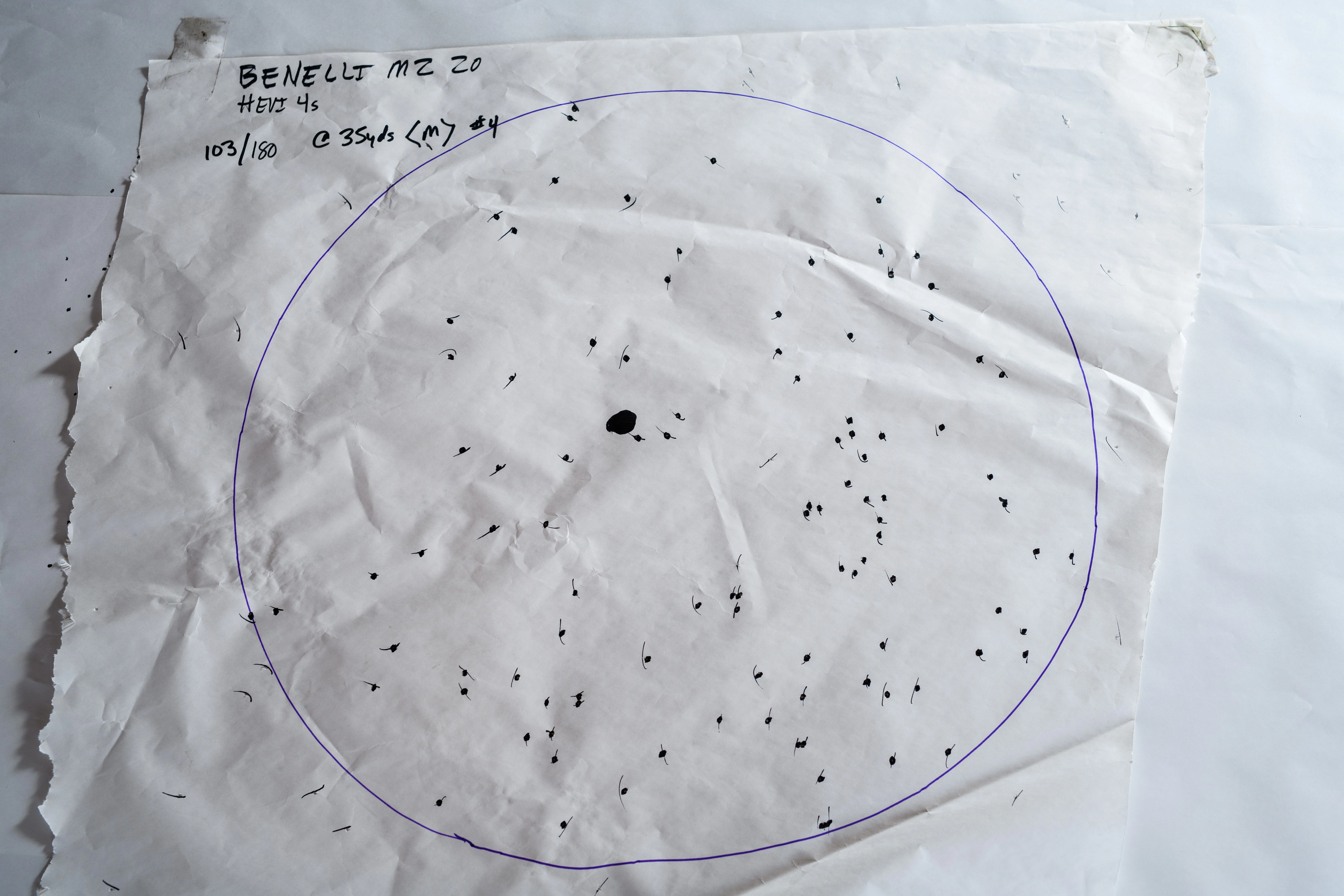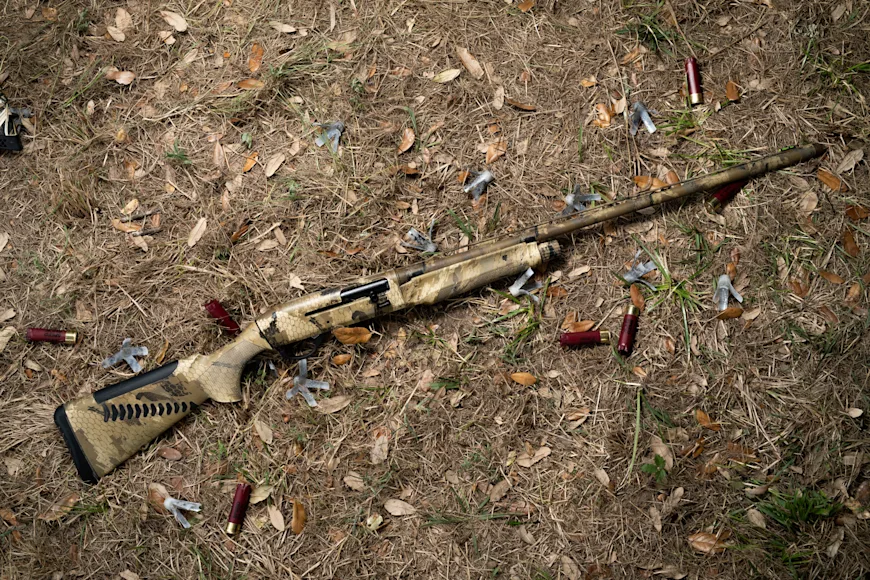_We may earn revenue from the products available on this page and participate in affiliate programs. Learn more ›
_
are the hot item in the duck blind
right now, as hunters discover that Bismuth
, HeviShot, and even steel loads in a 20 gauge can do almost as well as a 12 at closer ranges. What you give up in long-range capability with a 20, you get back in light weight and lower recoil. Benelli has been one of the leaders of the 20-gauge waterfowl gun trend, introducing a 20-gauge Performance Shop tricked-out version of the M2 semiauto to complement the standard M2 lineup. The majority of waterfowl guns are still 12s, and that was reflected in the guns we tested last September during our duck gun test
, but we brought a 20-gauge Performance Shop M2 with us to see how it performed.
Benelli inertia semiautos changed the way people think about waterfowl guns. The clean-shooting inertia system set new standards for semiauto reliability when it first appeared in the United States in the late 1980s. Hunters discovered the new guns were light, easy to maintain, and they worked in conditions that would strangle a gas semiauto. Benellis weren’t cheap, but hunters who aspired to the best started buying them.
The famous Super Black Eagle’s
stablemate, the M1 Super 90, became popular among those who didn’t need the all-load versatility of a 3 1/2-inch gun. In 2004, Benelli lightened the M1 and called it the M2. It has been made in 12 and 20 gauges, and if you visit a South American dove lodge, you’re likely to find the house rental guns are mostly 20-gauge M2s. Since high-volume dove shooting is to regular hunting what a NASCAR race is to a trip to the store, that endorsement speaks volumes about the M2’s reliability.
Currently, the M2 is made in 12 and 20 gauge, in black synthetic and camo versions. In addition to the standard M2, Benelli also offers Performance Shop M2s in both turkey and waterfowl versions.
Nuts and Bolts of the Benelli M2 Performance Shop

Benelli M2 Performance Shop Specs
Gauge: 3-inch 20
Action: Inertia semiauto
Capacity: 3+1
Chokes: Rob Roberts extended T1, T2, T3
Barrel: 28 inches, stepped rib, HiViz signt
Finish: Optifade camo
Length: 48 ½ inches
LOP: 13.7 inches
Trigger Pull: 6.5 pounds
Overall Weight: 5.9 pounds
Although the idea for inertia guns had been around since 1910, it wasn’t until the 1960s, when the Benelli family partnered with an engineer named Bruno Civolani in the Italian city of Urbino, that the era of inertia truly began. And it wasn’t until Civolani put a rotary bolt in the M1 Super 90 in the 1980s that inertia guns took the form we know and rely upon today.
Like all inertia guns, the M2 has a two-piece bolt with a heavy spring inside. As the gun recoils, the bolt remains stationary, and the rotary bolt actually locks up tighter as the gun moves backward. As the gun slows, the compressed spring inside of the bolt rebounds, throwing it backward and ejecting the fired shell. The return spring in the stock drives the bolt forward and it picks up a fresh shell from the lifter as it moves forward. Because the inertia action makes no use of expanding gases as gas-operated semiautos do, it remains very clean, and there are no gas pistons or sleeves on the magazine tube to add bulk to the front of the gun.
The M2 has a one-piece lightweight alloy receiver that makes it easy to distinguish from the SBE, which has a two-piece alloy and steel frame. Because inertia guns are lightweight and the actions don’t reduce recoil as well as gas actions to, the M2 features Benelli’s ComforTech stock, which has a very soft butt and cheek pads as well as rubber chevrons in the stock designed to reduce vibration. ComforTech really does work. I’ve shot an M2 alongside my own Benelli of identical weight but without ComforTech, and there’s a noticeable difference in kick.
How We Tested the Benelli M2 Performance Shop
We took the M2 teal hunting
in the mornings and shot targets with it in the afternoon at Pintail Hunting Club’s
clays range. We tested the gun for both point of impact and to see how it patterned with hunting loads at 35 yards. We weighed it, measured, and checked the trigger pull. Our test gun patterned slightly low, and made a 57-percent pattern at 35 yards with the Rob Roberts T2 choke. Since the T2 corresponds closely to a Light Modified constriction, that pattern fell inside the range I would have expected. The trigger broke at 6.5 pounds, which is a little heavy, although not a problem for me or other members of the test team.

We patterned the M2 Performance Shop at 35 yards. Stephen Maturen
It turns out the M2 Benelli sent us to test was the exact same gun I hunted with extensively the previous season, so I know the gun patterned quite well with Rio 1-ounce loads of bismuth 3 shot. I was also able to give it a season-long reliability test (which is not quite as impressive as it sounds, given just how bad my season was) and shoot the M2 quite a bit at my gun club.
How the Gun Performed
Handling and Ergonomics
At 5.9 pounds with a 28-inch barrel, the M2 straddles the line between “light and handy” and “too light to shoot.” For teal, and for ducks over decoys, it’s just the thing: light, trim, and quick to the target. As shots stretch out to the edge of 20-gauge range, the gun becomes a little harder to manage, and honestly some extra heft would help. That’s how I felt about the gun anyway, after shooting it at home and in Texas. Like all Benellis, it points well due to the slim forend that lets the barrel sit down lower in your hands than is typical with semiautos, and the balance is closer to that of a break-action gun than it is to a gas semiauto. The ComforTech stock really does work to reduce recoil and vibration. The gun was comfortable to shoot.
All M2s have a big, easy-to-find, easy-to-reverse, triangular safety button. Among the extra added to Performance Shop guns are the enlarged bolt handle and bolt closer buttons which made it easier to use with cold or gloved hands.
Workmanship and Aesthetics
The M2 is a good-looking semiauto. With its has sleek lines and stepped rib it looks contemporary without trying to look too modern. It feels good in your hands and, while synthetic stocks involve no craftsmanship at all, the furniture on the gun looks good and feels right in your hand, especially the slightly enlarged forend.
Like any Benelli, the M2 is made by machines that work to extremely tight tolerances. At the Benelli factory, the management likes to say, “We don’t make Benellis, we clone them.” The guns are uniformly well fit and finished. This M2 is no exception.
Versatility
Although the gun we shot is billed as a waterfowl model, and the duck blind is definitely its first home, you could absolutely use the M2 for both upland birds and waterfowl. It’s a little long for turkey hunting, and it has no sights, but our gun shot close enough to point of aim that you could use the bead to make head and neck shots on a gobbler if you added a turkey choke. The M2’s light weight would make it less than ideal as a clay target gun, since some heft makes shooting clays easier, but you could use it for a few rounds of skeet or sporting clays.
Reliability
The M2 shot everything we ran through it, and I shot mine without cleaning it during a season at home. It never failed to cycle. However, the one annoying fault of the rotary-bolt inertia design is the infamous “click” misfire that occurs when the bolt isn’t shut all the way. If you ease the gun shut, or if you manage to bump the bolt handle the right way, the gun won’t shoot. A couple of times when I hunted with the gun at home I managed to snag the bolt handle—once on a ghillie suit, the other time in some camo netting—and a misfire resulted with ducks over the decoys. I couldn’t help but think the larger bolt handle made the gun more likely to experience such problems. I have never seen the point of larger handles or bolt releases on hunting guns (they are great on target guns), but they are popular right now on hunting guns and it’s hard to find a duck gun without them. And, honestly, if you hunt in a regular blind, boat, or layout, the chances of bumping your Benelli out of battery are slim.
Value
The M2 Performance Shop has a lot of good qualities, but value isn’t one of them. It costs more than $1,100 than a standard M2. For that money, you get three aftermarket choke tubes, an extended forcing cone, the paracord sling, and the enlarged bolt and bolt release. You could add all of these extras—assuming you wanted them—for well under $1,100. Or you could buy a regular M2 and hunt with it. I did find when I patterned the Performance Shop gun compared to some of my other 20s that it did shoot much better with the Rio bismuth I used, but you should be able to find a custom choke you like for the gun without having to spend Performance Shop money.
What the Benelli M2 Performance Shop Does Best
The Performance Shop M2 Waterfowl is at its best on a ducks-over-decoys hunt, especially if it’s a walk-in hunt where a light, trim gun makes a difference on the hikes in and out. I could see it as a terrific dove gun, too, and even as the ideal gun to bring on a teal-in-the-morning, doves-in-the-afternoon hunt. It would make a nice open-county upland gun as well. Its long overall length might make it a little tough to handle in a grouse or quail thicket, but for walking grass fields for pheasants or sharptails, it might prove ideal.
What the Gun Does Worst
As much as I enjoy shooting the Performance Shop M2, it doesn’t deliver the value to justify the extra $1,100 you pay for the custom chokes and forcing cones. It’s a great hunting gun, but you spend a lot to get extras that add only slightly to the gun’s performance over the already excellent standard M2.
Final Thoughts
If money is no object and you want a lightweight, durable 20 gauge, then the M2 Performance Shop Waterfowl gun definitely merits a look. While you could add most of the extras for much less, the Perfomance Shop gun is a turn-key, field-ready deal. It offers every bit of the all-conditions reliability Benellis are known for in a lightweight package that is a joy to handle.






